We’ve got a bone to pick with ab exercises: They’re usually boring. Unfortunately, exercising your abs is a bit like eating your vegetables. It’s tedious, but necessary — this goes for both appearances and performance.
However, we aren’t entirely sold on the idea that your ab workouts have to be dull as a doorknob. In fact, you might just be performing the wrong moves.
“The right ab-training exercises can both sculpt and strengthen your core while also being dynamic, engaging, and fulfilling to perform,” says Jake Dickson, BarBend Senior Writer and certified personal trainer. Want to know what the best ab exercises really are? Here are a dozen of our go-to’s:
12 Best Ab Exercises
- Ab Rollout
- Weighted Plank
- Hollow Hold
- Cable Crunch
- Sit-Up
- Hanging Knee Raise
- Farmer’s Carry
- Side Plank
- Plank
- Dead Bug
- Mountain Climber
- Bird Dog
Editor’s Note: The content on BarBend is meant to be informative in nature, but it should not be taken as medical advice. When starting a new training regimen and/or diet, it is always a good idea to consult with a trusted medical professional. We are not a medical resource. The opinions and articles on this site are not intended for use as diagnosis, prevention, and/or treatment of health problems. They are not substitutes for consulting a qualified medical professional.
What Muscles Make Up the Abs?
Your core contains multiple muscles, and understanding what they are and how they work is important in obtaining a stronger, better-looking midsection. Here’s a breakdown of the major core muscles.
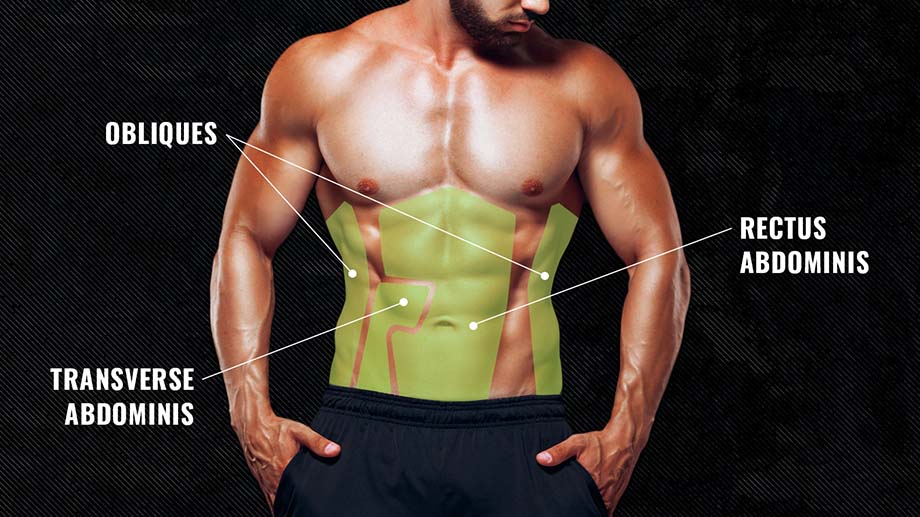
- Rectus Abdominis: The rectus abdominis runs vertically up the front of the torso and is responsible for spinal flexion. This muscle group is often the most targeted when people train their core, which is why many tend to focus on sit-ups and crunches.
- Obliques (Internal and External): Your obliques run diagonally along the torso’s sides and are responsible for rotational force output and resisting rotational stress on the spine. Think Pallof presses, suitcase carries, side planks with rotations, and any other moves that emphasize either rotation or anti-rotation.
- Transverse Abdominis: This is a deeper muscle group that helps to stabilize the core and spinal structures. You can target the transverse abdominis with planks, holds, and other total-body movements that require general postural control.
[Read More: Try Our Picks for Lower Chest Exercises]
1. Ab Rollout
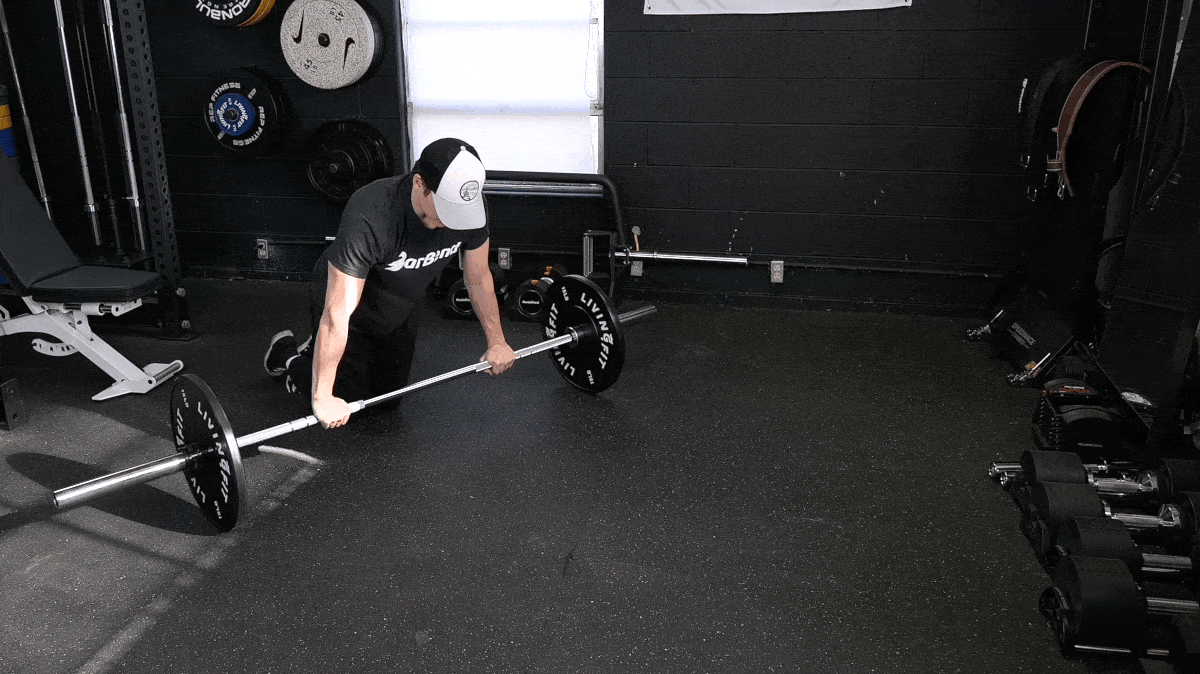
| Equipment Needed | Ab wheel or barbell, exercise mat (optional) |
| Muscles Worked | Abdominals, lats |
| Sets & Reps | 2-4 x 5-10 |
As the name implies, the ab rollout has you grip a barbell (loaded with round plates), an ab wheel, or an exercise ball to extend your torso toward the ground. Most stomach movements, such as crunches and knee raises, flex the abs. The ab rollout strengthens the core by providing an ab stretch, which targets what’s known as eccentric strength.
How To Do It
- Kneel and grip a wheel or barbell, loaded with round plates, with your hands set shoulder-width apart.
- Extend your hips toward the floor and let your chest sink forward toward the ground. Avoid arching your lower back as you extend your arms above your head.
- Squeeze your lat muscles and pull yourself back to the starting position.
Modifications
- Make It Easier: Use a barbell with plates instead of an ab roller to elevate the wheels, which should let you access a longer range of motion.
- Make It Harder: Pause at the bottom of each repetition to build strength while your abs are stretched.
2. Weighted Plank
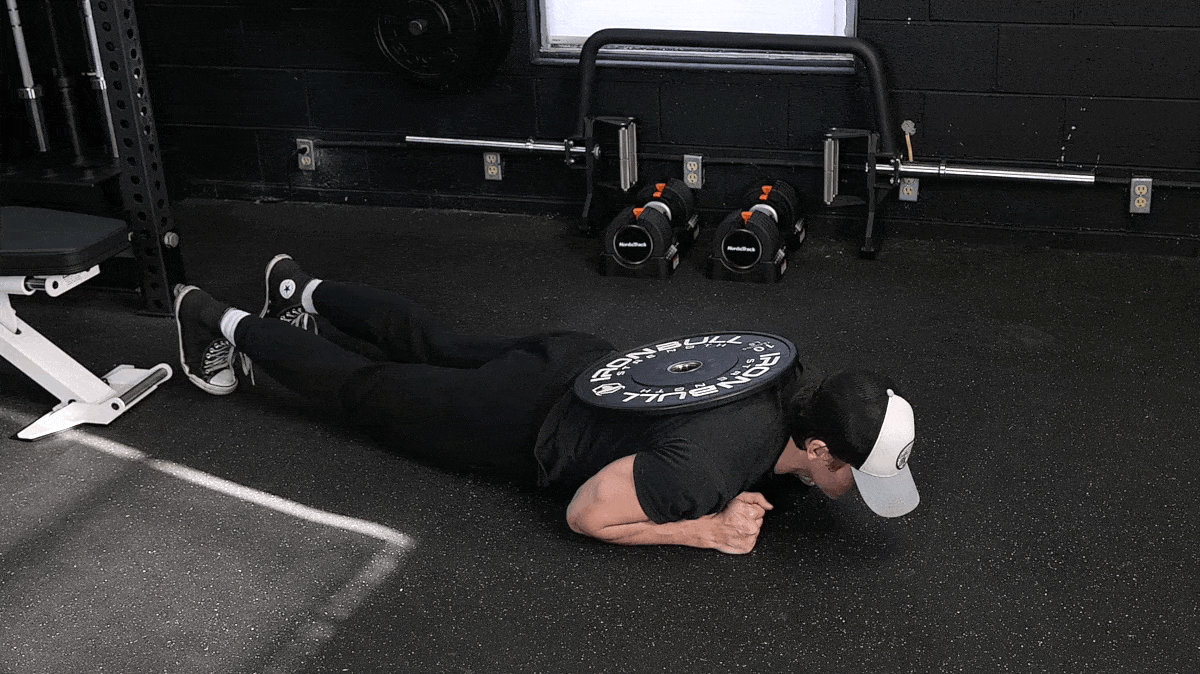
| Equipment Needed | Weight plate, exercise mat (optional) |
| Muscles Worked | Abdominals |
| Sets & Reps | 3 x 20 seconds |
The plank is a classic core move that involves holding the top of a push-up position — either on your hands or on your forearms — for time. The tension created by flexing the abs to keep your back straight is immense.
The weighted plank is a more advanced variation that increases the difficulty by adding more downward force to the exercise. It also gives you more isometric strength, which helps keep the spine neutral during moves like squats, deadlifts, and snatches.
How To Do It
- Assume a plank position, with your hands or forearms on the floor.
- Align your hips and shoulders so that you’re as parallel to the floor as can be.
- Squeeze your glutes and quads, bearing down on your core from all sides.
- Have a spotter place a weight plate under your shoulder blades or, if it’s a relatively light one, position it behind you yourself. Press your arms, hard, into the floor and hold this position for time.
Modifications
- Make It Easier: You can do planks on your knees instead of with straight legs as a beginner.
- Make It Harder: Try the long lever plank, with your elbows on the ground in front of your head rather than under your shoulders.
3. Hollow Hold
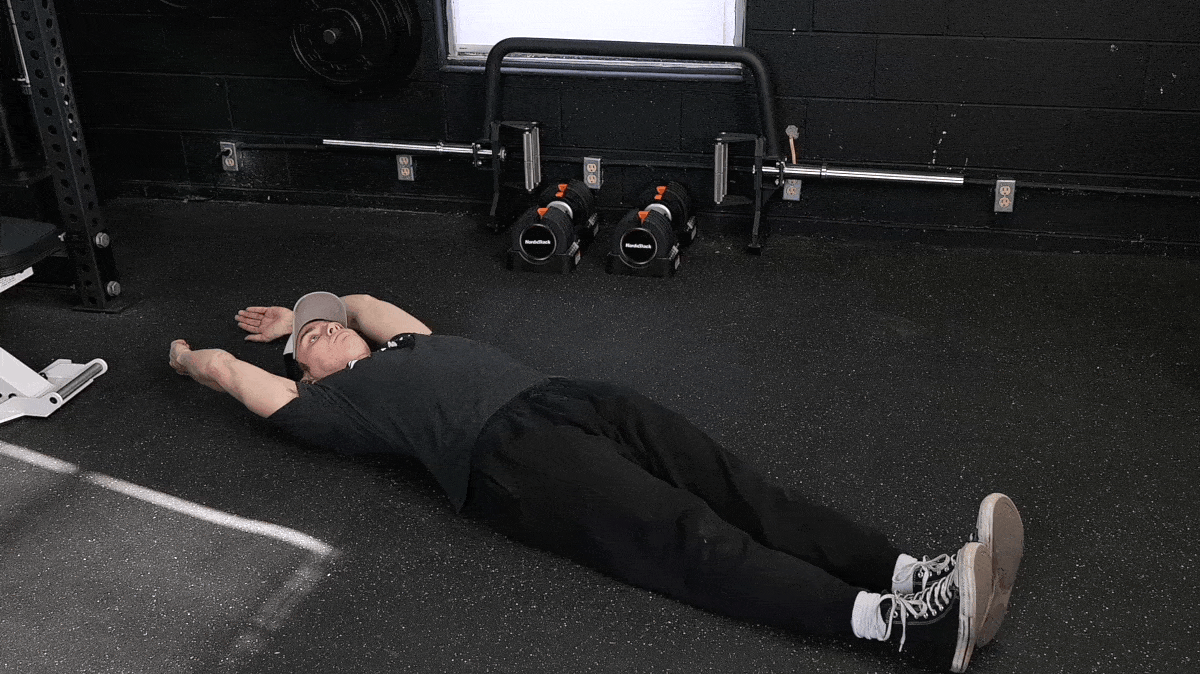
| Equipment Needed | Exercise mat (optional) |
| Muscles Worked | Abdominals, hip flexors |
| Sets & Reps | 2-3 x 10-20 seconds |
The hollow hold calls for you to balance on your butt, with your legs a few inches off the floor and your arms over your head. Extending your arms and legs away from your body (and the center of mass) decreases your stability so your abs must work harder to keep you upright.
This upper abs exercise builds isometric strength and anti-rotational strength, giving you practice at creating tension through your core — something you’ll need under a loaded barbell.
How To Do It
- Lie on your back with arms extended overhead and legs pressed together.
- Lift your legs and upper torso off the floor.
- Hold this position.
Modifications
- Make It Easier: Try lifting only your arms or legs one at a time before lifting both to make the move easier to coordinate.
- Make It Harder: Adding a rocking motion to this exercise creates even more instability and therefore recruits more of the core.
4. Cable Crunch
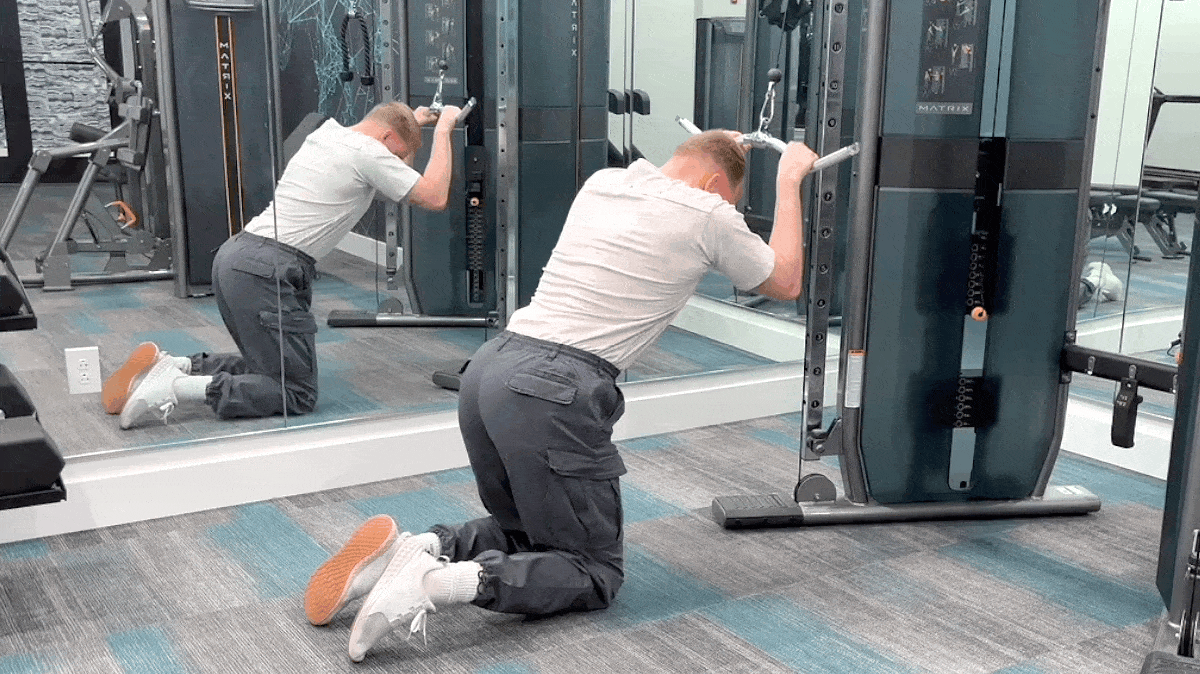
| Equipment Needed | Cable station, attachment of choice |
| Muscles Worked | Abdominals |
| Sets & Reps | 3-4 x 8-12 |
We get sick of crunches and leg raises, too. Luckily, you can head over to the cable machine and perform a top-tier ab-building movement by banging out a few sets of cable crunches.
“The cable crunch belongs in any bodybuilding abs workout. It takes your core through a full range of motion against resistance,” Dickson says. These are a staple of ours — they belong in your toolbox as well.
How To Do It
- Fix an adjustable cable to around eye level and secure your attachment of choice.
- Grab the attachment and step back from the cable, getting down into a full kneeling stance.
- Hold the attachment gently in your hands either in front of your face or behind your head.
- Exhale and crunch down, bringing your head toward the floor and rounding your spine. Don’t pull on the cable with your arms.
Modifications
- Make It Easier: You can do cable crunches standing up with light weights as well.
- Make It Harder: Try supersetting cable crunches with regular planks for a real burn.
5. Sit-Up
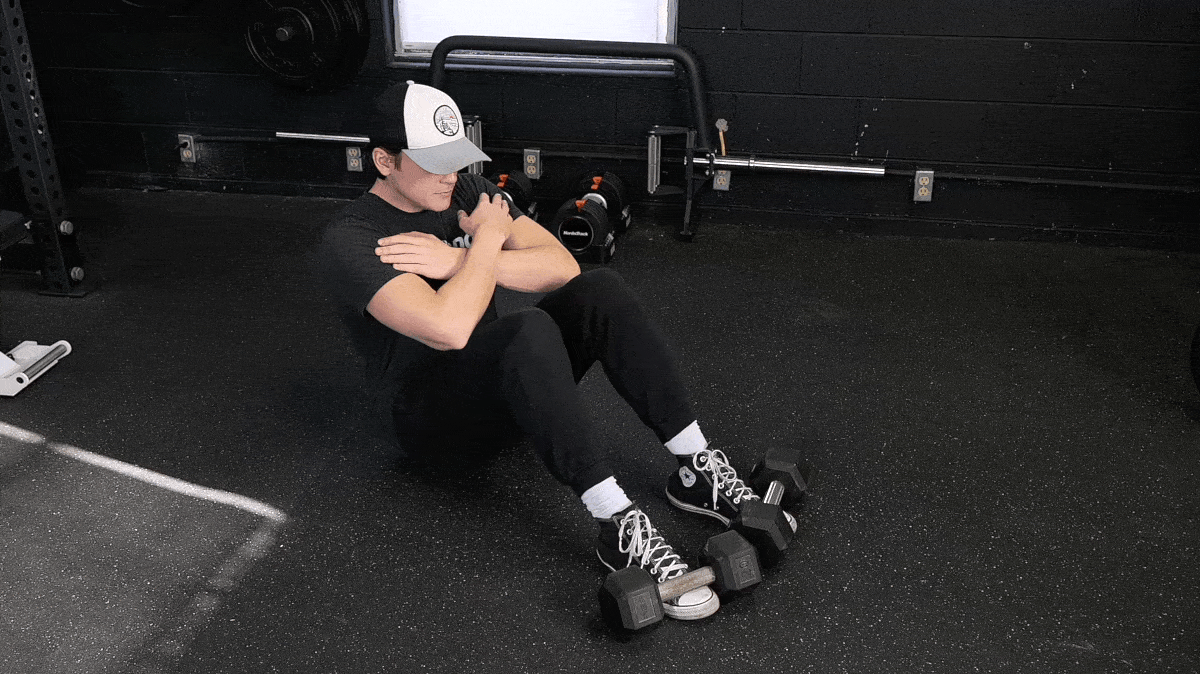
| Equipment Needed | Exercise mat (optional), weight plate (optional) |
| Muscles Worked | Abdominals, hip flexors |
| Sets & Reps | 2-3 x 15-20 |
You might have been neglecting full sit-ups in favor of crunches or bicycle crunches. And while we don’t mind those moves, the sit-up — as long as you’re performing it with your abs rather than hip flexors, shoulders, or neck — takes you through a more effective range of motion.
[Read More: The Best Ab Exercises and Sit-Up Alternatives for a More Powerful Core]
You can easily pump out a lot of reps in the classic sit-up. This means you can accumulate lots of training volume. It also requires zero equipment with little to no spinal loading.
How To Do It
- Lie flat on the floor with your knees bent at 90 degrees and your hands across your chest.
- Contract your abs to pull your torso up to your knees.
- Squeeze your core at the top and slowly descend back down.
Modifications
- Make It Easier: If you can’t do full sit-ups yet, start with regular crunches, which have a smaller range of motion.
- Make It Harder: Hold a weight plate in your hands in front of you to add some external load.
6. Hanging Knee Raise
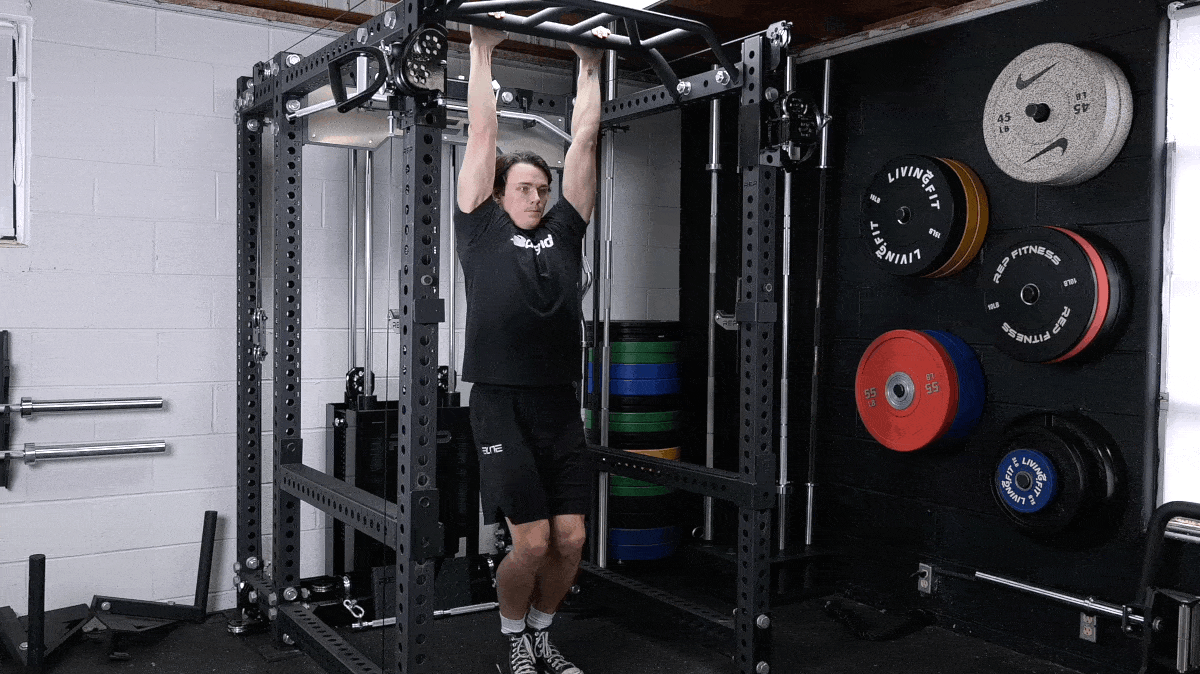
| Equipment Needed | Hanging leg raise station or pull-up bars |
| Muscles Worked | Abdominals, hip flexors |
| Sets & Reps | 3 x 10-15 |
Like the sit-up, the hanging knee raise is a beginner- and intermediate-friendly chest exercise that requires minimal equipment and is excellent for strengthening your core. It’s also very scalable — you can straighten your legs or hold a dumbbell between your knees to make the move harder.
We also want to go to bat for this move because of its customizability, making it one of the best ab exercises. Hanging from a bar will seriously boost your grip strength which will help with exercises such as deadlifts, farmer’s carries, and pull-ups. Other benefits include more postural control over your torso and even better grip strength.
How To Do It
- Hang from a pull-up bar with a slightly wider grip than shoulder-width apart.
- Keep your shoulder blades back and down.
- Press your legs together and pull your knees up to chest height without using momentum.
- Unfurl and return to the starting position with slow control.
Modifications
- Make It Easier: Use the chair station with the backrest and bend your knees as you lift your legs.
- Make It Harder: Suspend yourself from a pull-up bar and keep your knees straight. Removing the back support forces your trunk muscles to work harder.
7. Farmer’s Carry
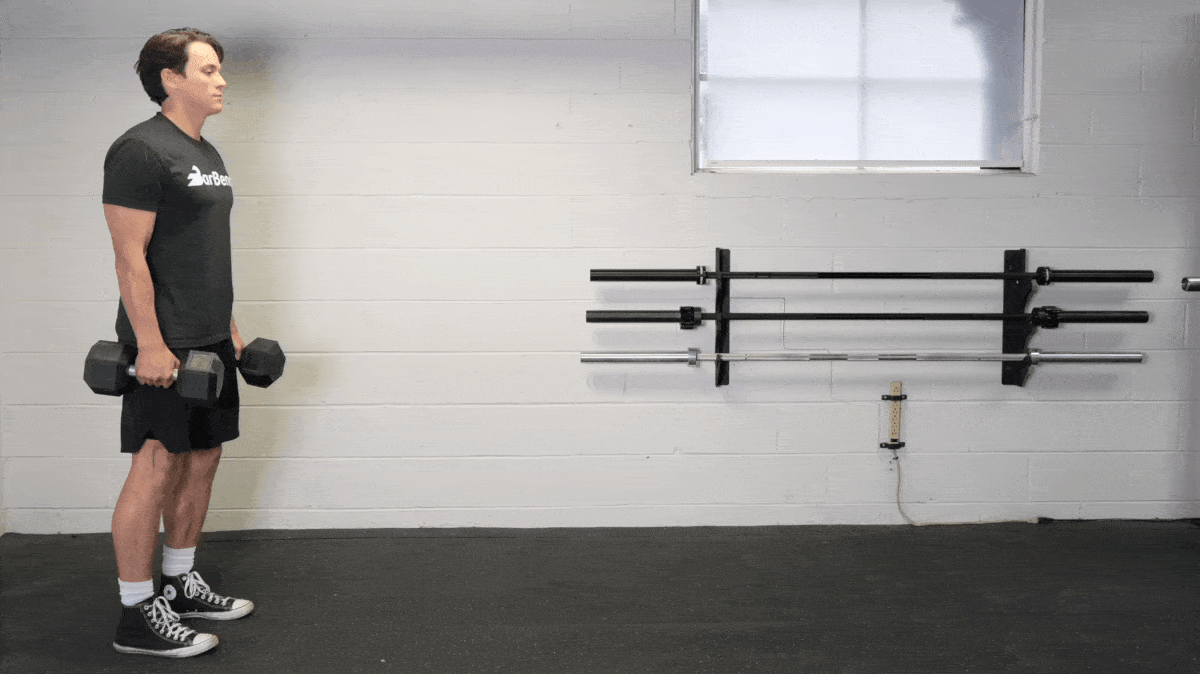
| Equipment Needed | Trap bar frame, dumbbells, or kettlebells |
| Muscles Worked | Obliques, abdominals, traps, grip |
| Sets & Reps | 2-3 x 20-30 paces |
We love loaded carries and walks — they’re functional and burn your abs to a crisp. When it comes to core stability and training, we also prefer to do a single-arm farmer’s carry, also sometimes called a suitcase carry. Holding one weight at a time not only forces your core to work hard to keep your body upright, but your abs also have to resist the weight pulling your trunk laterally.
How To Do It
- Select a weight that’s about 25 percent of your body weight.
- Pick up the weight, squeeze the handle, and make sure your shoulders are not tilting to one side or the other.
- Walk slowly in a straight line, putting one foot in front of the other. Your opposing arm can be kept at your side or held out for balance.
Modifications
- Make It Easier: Try double-armed farmer’s carries to remove the side-to-side instability.
- Make It Harder: Do high knee marches as you step instead of just walking to train your hip flexors.
8. Side Plank
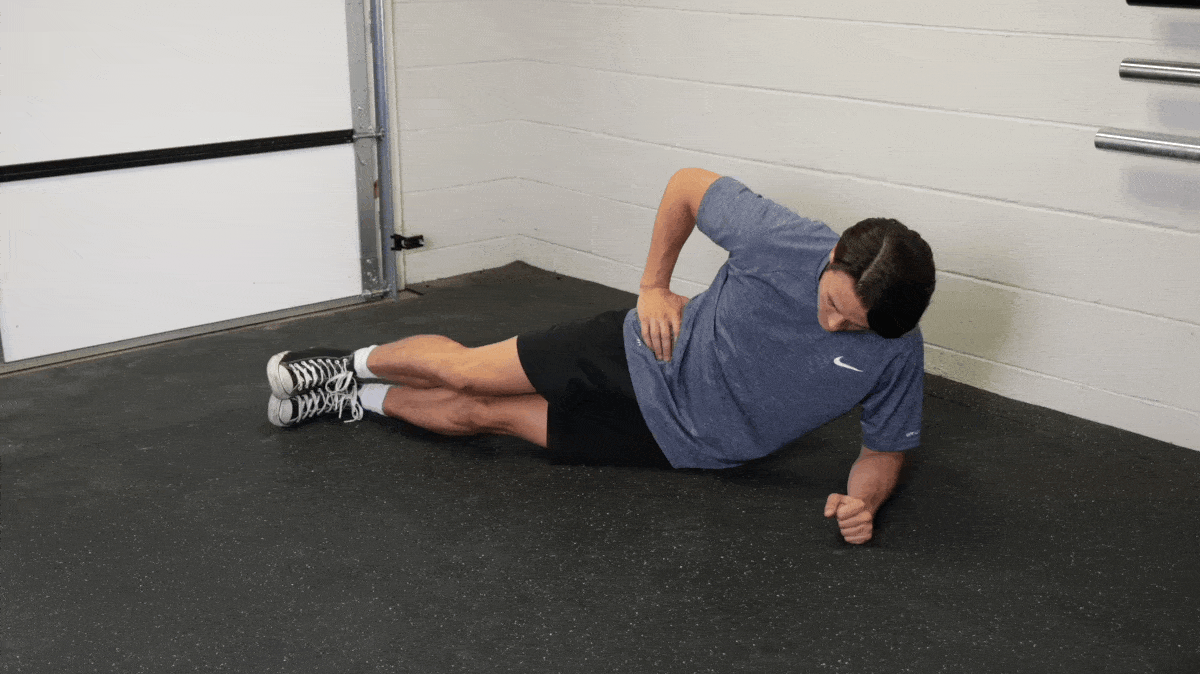
| Equipment Needed | Exercise mat (optional) |
| Muscles Worked | Obliques, abdominals |
| Sets & Reps | 2-3 x 30-45 seconds |
Don’t be fooled by its popularity. The side plank is tough to pull off. If you need to customize this move to your strength or balance level, stack one foot in front of the other instead of putting your feet on top of each other. This isometric exercise will train you to maintain your hip position under tension, which can translate into a much more stable core.
How To Do It
- Lean on your side and place one forearm or hand on the ground underneath the corresponding shoulder.
- Stack one foot on top of or in front of the other.
- Press your hips up toward the ceiling, maintaining a line between your shoulders and your hips as much as possible.
- Breathe slowly and deeply, holding the position for a set period. Switch sides and repeat.
Modifications
- Make It Easier: Do side planks with your knees bent and with your lower leg in contact with the ground. This provides a point of ground contact that’s closer to your center of mass.
- Make It Harder: Lift your top leg up in the air and hold it there for the entire set.
9. Plank
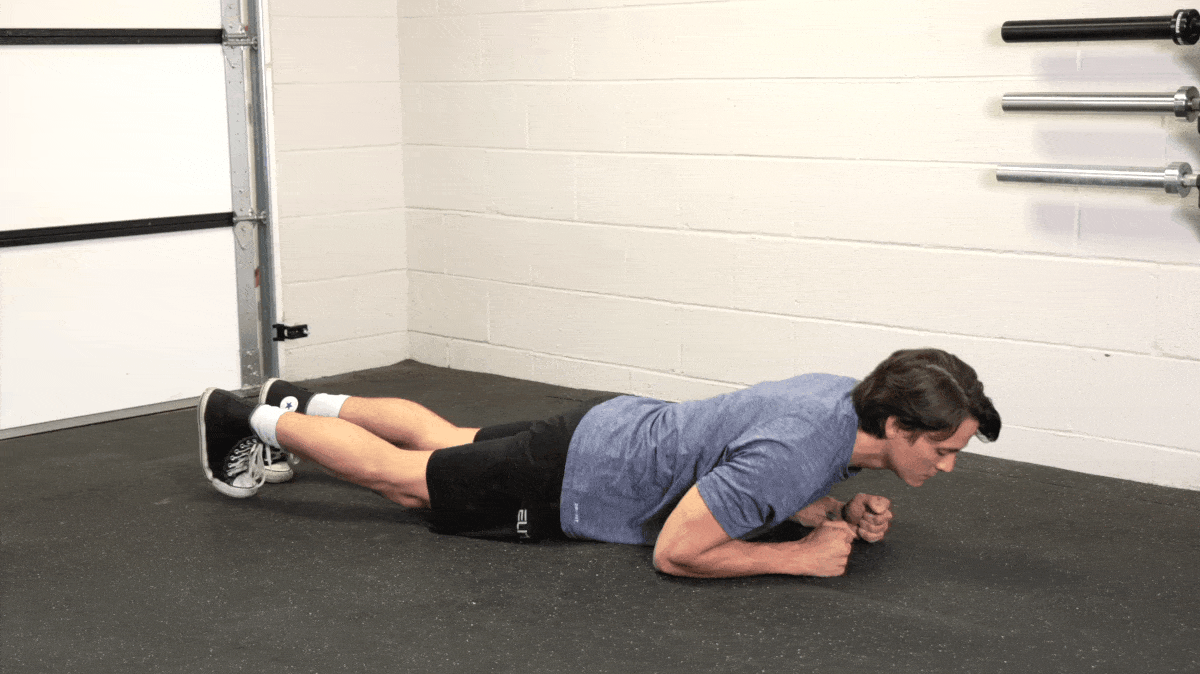
| Equipment Needed | Exercise mat (optional) |
| Muscles Worked | Abdominals |
| Sets & Reps | 3-4 x 30-90 seconds |
At BarBend, we love the basics. The standard front plank is, in many ways, the bedrock of all core training and one of the best ab exercises. This accessible, easy-to-perform beginner core exercise teaches you how to brace your torso while you lift and maintain proper spinal alignment.
“Anyone who wants stronger abs should master the plank. If you can learn to brace and stabilize your body from head to toe, your abs will get stronger while also learning how to support your trunk while you lift with your arms or legs,” Dickson notes.
How To Do It
- Get down on the ground on your stomach with your legs extended straight and your arms tucked to your sides.
- Place your elbows on the ground under your shoulders to prop you up, then lift your body off the floor.
- Hold the position, taking deep belly breaths without letting your hips sag down to the ground.
Modifications
- Make It Easier: Do planks on your knees first before moving on to the straight-leg variation. Knee planks are more stable for beginners.
- Make It Harder: Try slowly picking up one foot off the ground and gently putting it back down. Alternate legs while you plank.
10. Dead Bug
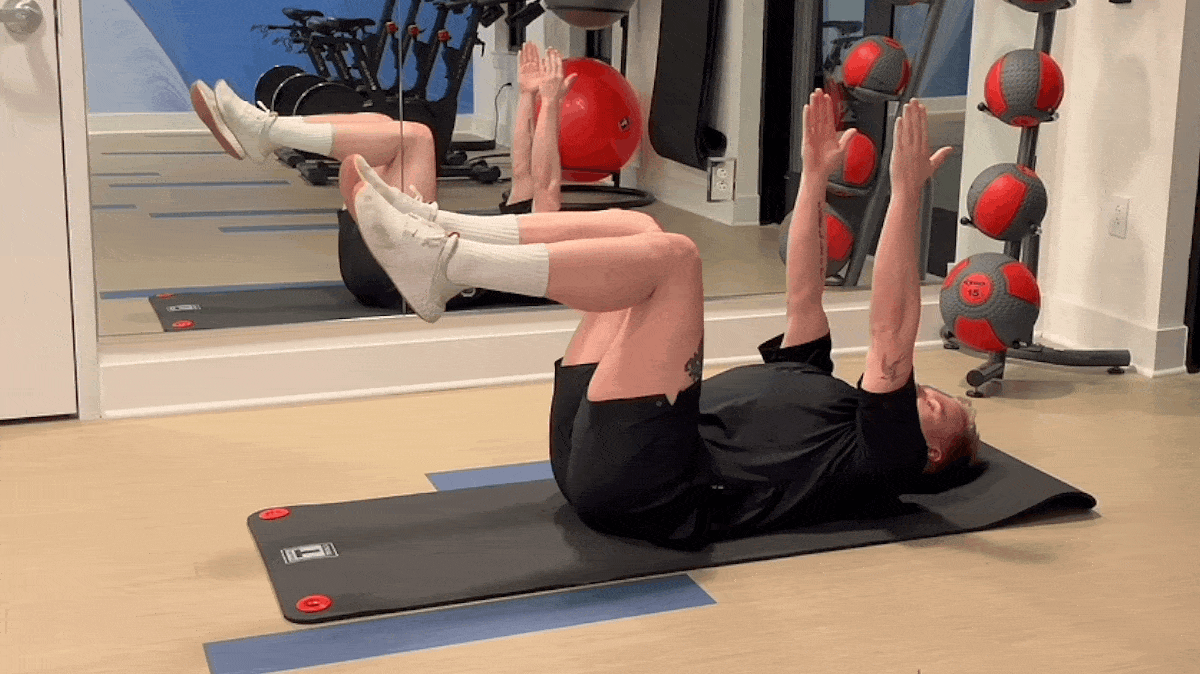
| Equipment Needed | Exercise mat (optional), weight plate (optional) |
| Muscles Worked | Abdominals, hip flexors |
| Sets & Reps | 3 x 10-15 |
We’ll let you in on a secret; dead bugs aren’t just for beginners. Top-tier strength athletes like powerlifters use this lower ab workout to prepare their core to stabilize against ultra-heavy weights. The dead bug exercise teaches you how to brace your abs while moving your limbs, which has heaps of carryover to strength training and real-world activity.
How To Do It
- While lying on your back, flex your hips to 90 degrees and keep your shins perpendicular to your thighs.
- Bear down on your core, tightening your legs and glutes.
- Straighten your right leg, extending it away from your body. At the same time, lower your left arm back behind your head.
- Alternate limbs, straightening and bending the opposite leg and arm that you started with.
Modifications
- Make It Easier: Try moving just your leg or arm, rather than both limbs at once, to make the move easier to coordinate.
- Make It Harder: Hold a small dumbbell in your non-moving hand and switch hands between reps.
11. Mountain Climber
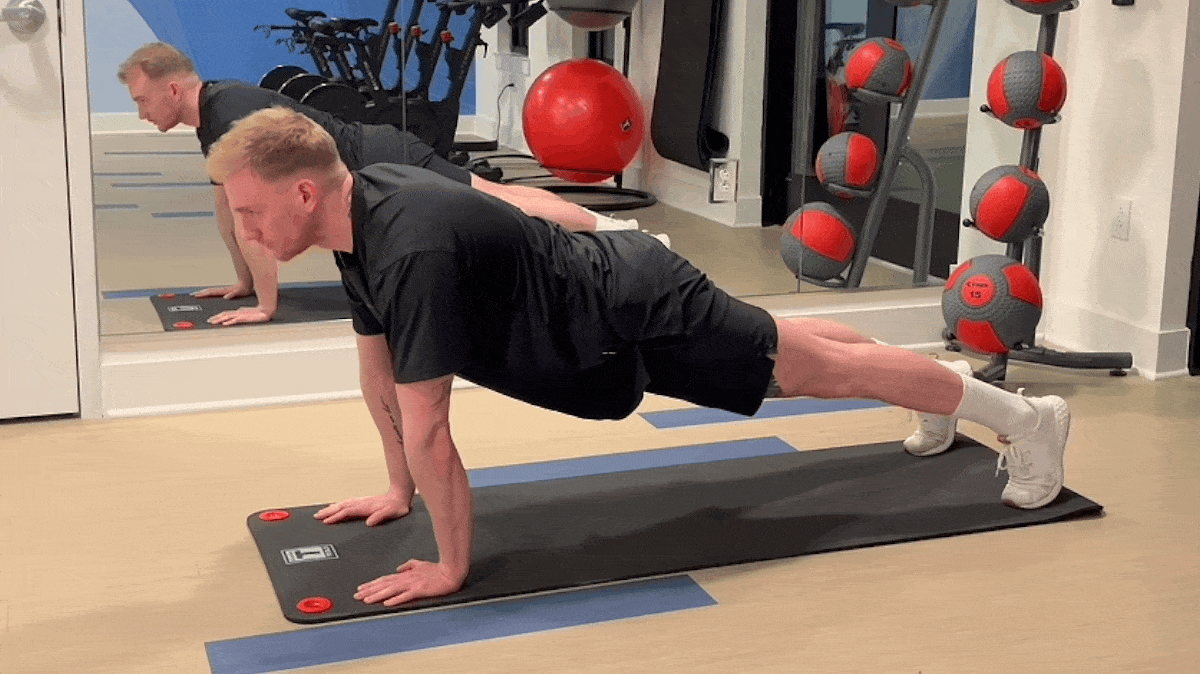
| Equipment Needed | Exercise mat (optional) |
| Muscles Worked | Abdominals, hip flexors, triceps |
| Sets & Reps | 3 x 20-30 |
Why do mountain climbers? Well, we’d say do them because they both train your core and will also burn calories like nothing else. This core exercise introduces some dynamic movement that will get your heart rate up and help you break a real sweat in the process.
How To Do It
- Get into a plank position with straight arms, rather than having your elbows on the ground.
- From here, bend one leg and pull your knee up toward your elbow.
- Place that leg back in the starting position and then immediately draw the opposite leg up to the same spot on the corresponding side.
Modifications
- Make It Easier: Try just lifting one leg off the ground a few inches, rather than pulling your knee up toward your armpit.
- Make It Harder: Balance a weight plate on your back. This introduces some external resistance, adding to the load on your core.
12. Bird Dog
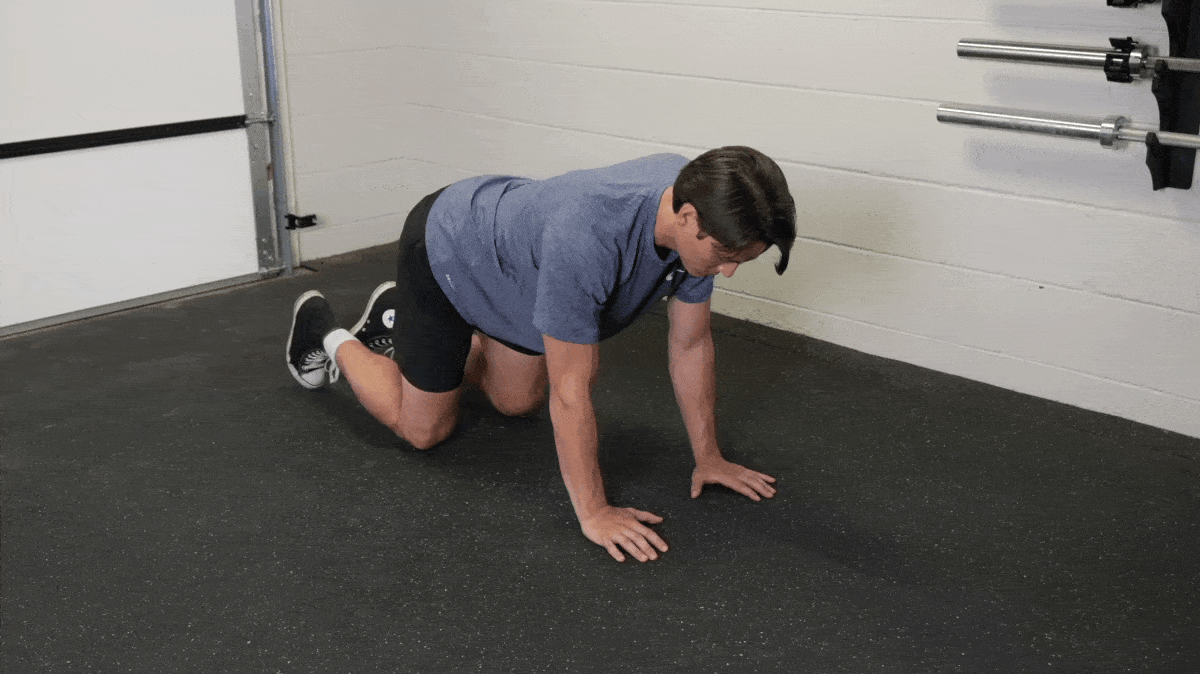
| Equipment Needed | Exercise mat (optional) |
| Muscles Worked | Abdominals, obliques, glutes |
| Sets & Reps | 2 x 10-15 |
Bird…dog? (Don’t worry, we were confused by the name at first too). This bodyweight exercise gets its namesake from the posture you assume at the end of each repetition, resembling a hunting dog in action. But when it comes to ab training, we like this one because it is a safe, versatile exercise to help introduce you to stability-focused oblique workout.
How To Do It
- Get on all fours.
- Simultaneously lift your left arm and right leg off the floor.
- Straighten your leg and arm until they form a straight line, pointing in opposite directions.
- Hold for a beat, lower your leg and arm down, and repeat on the opposite side.
Modifications
- Make It Easier: Try moving only one leg or arm at a time rather than both simultaneously, or just lift your foot and hand off the ground slightly rather than straightening your limbs.
- Make It Harder: Lift your non-moving knee off the floor just a hair as you move the other leg.
4 Ab Workouts to Incorporate
Stronger abs grant you a better ability to brace during heavy lifts. And for those who are trying to cut down, bigger ab muscles create that rigid blocky appearance most people covet. That said, here are four of the best ab workouts for specific training goals.
“Depending on the segment of abs you’re trying to target, here’s the simple breakdown: If you want to target your lower abs, anchor your upper body and flex your lower body space. If you want to target your upper abs, anchor your feet and hips and flex your upper body. If you want to target your obliques, you can side bend or rotate through your waist,” Masi recommends.
Ab Workout for Muscle Mass
You’ll want to prioritize the best ab exercises with weights here, as adding external load is likely to help you hit failure faster. And the more often you approach true muscle failure, the more likely you are to stimulate some serious muscle growth.
[Read More: Everything You Should Know About Training Your Core]
If you want to build muscle with abdominal exercises, mindlessly banging out so-called ab-toning exercises like crunches won’t do it. Instead, think about moving slowly and with intention, moving the weight while concentrating on the contractions in your abdominal muscles.
You can perform this workout two to three times per week. Rest for about 30 to 45 seconds between sets.
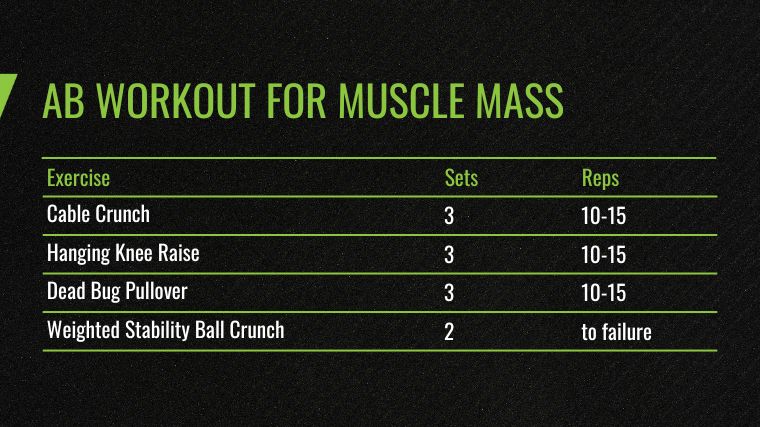
Equipment Needed: Cable machine, pull-up bar
- Cable Crunch: 3 x 10-15
- Hanging Knee Raise: 3 x 10-15
- Dead Bug Pullover: 3 x 10-15
- Weighted Stability Ball Crunch: 2 sets to failure
Ab Workout for Core Strength
To strengthen your abs, a good place to start with abdominal workouts for core strength is with isometric, or non-moving exercises such as the plank.
You can also supplement your workouts with dynamic exercises, which will challenge your body’s ability to remain stable and neutral while in motion (as many exercises and everyday activities such as running and jumping demand).
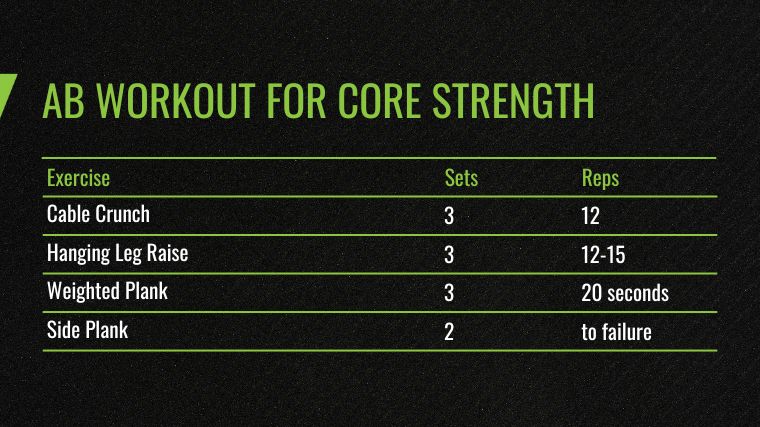
Equipment Needed: Cable machine, pull-up bar
- Cable Crunch: 3 x 12
- Hanging Leg Raise: 3 x 12-15
- Weighted Plank: 3 x 20 seconds
- Side Plank: 2 x failure
Ab Workout for Beginners
Although beginner core workouts might seem fairly straightforward, the burn that often sets in midway through a set — or the shaking during a plank — can be extremely intimidating. To find the best ab exercises for beginners, choose movements that you feel relatively comfortable with and use modifications when you need (for example, doing planks from your knees).
You want to be challenging yourself, sure, but leave enough room for plenty of enjoyment that you’ll want to come back again. Try resting for 45 seconds between sets, but extend that time if you need to.
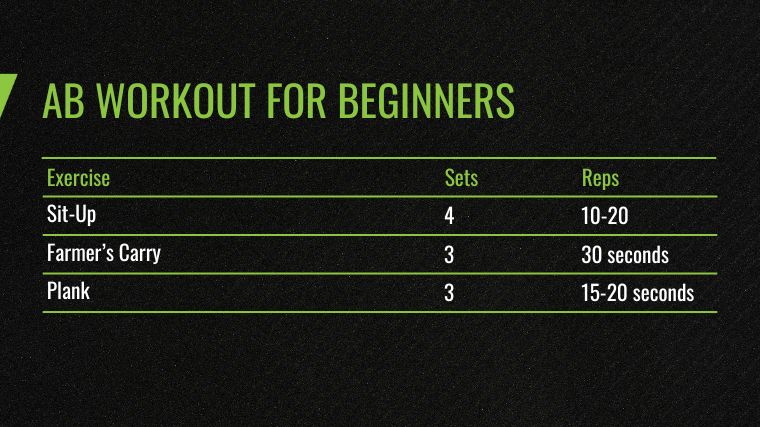
Equipment Needed: Free weights, resistance band
- Sit-Up: 4 x 10-20
- Farmer’s Carry: 3 x 30 seconds
- Plank: 3 x 15-20 seconds
[Read More: Our Favorite Upper Chest Exercises]
Bodyweight Ab Workout
Our favorite bodyweight ab exercises and workouts hit the core using isometric holds and high-repetition sets. Intensify the challenge by adding time or repetitions while squeezing as hard as possible. Perform this routine three times per week with 30 seconds of rest between movements.
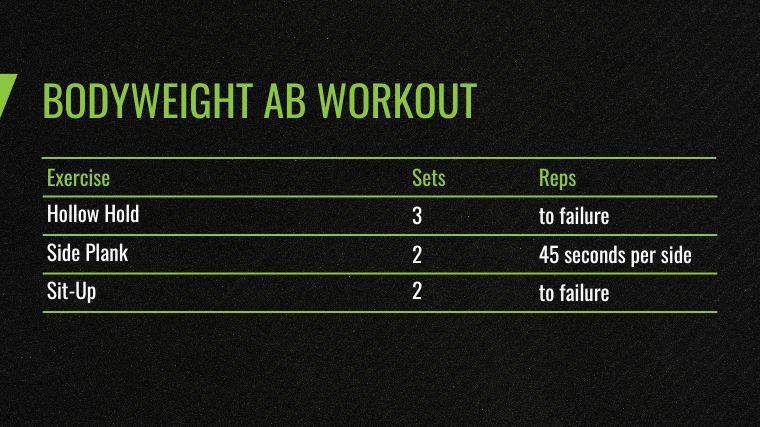
- Hollow Hold: 3 sets to failure
- Side Plank: 2 x 45 seconds per side
- Sit-Up: 2 sets to failure
Benefits of Training Your Abs
Forging a strong set of abs isn’t just about a six-pack — though that might be important to physique-oriented athletes. Building up strength in your abs is also a highly functional addition to any strength training or functional fitness program.
“Your core is the bedrock of your body’s overall movement patterns,” says Dickson. “Movements you do with your arms or legs depend on a strong and stable set of abs.”
“A lot of people save their abs for the end of their workouts. If this is an area you’re trying to prioritize, it’s better to perform these in your warm-up while you’re still fresh,” Masi says. “Plus, it’ll act as a good warm-up for your strength exercises later in the workout.”
Boost Spinal Stability
Squats, presses, pulls, and other loaded movements all require spinal stability to prevent the athlete from experiencing a severe injury like a slipped disc or muscle tear. A strong core allows an athlete to stay rigid under immense pressure from loaded barbells.
Of course, strong abs cannot guarantee an injury-free training experience. However, the more spinal stability you have, the more resilient your body is likely to be against injury while you’re training under heavy loads.
Strengthen Barbell Lifts
Yes, deadlifts and squats alone will improve your core strength. But if you want to bring your compound lifts to the next level to hit your next one-rep max, a core-specific workout routine is non-negotiable.
Athletes who want to heft heavy barbells have to develop strong abs. They will help you hold a strong, effective core brace and ensure that you’re transmitting force as efficiently as possible from your body through the barbell.
Improve Functional Fitness
If you have a weak core, it’s going to be harder to go about your activities of daily living. Even going for walks requires your abs to be strong to help you maintain good posture and prevent unnecessary and potentially pain-inducing swaying.
[Read More: How Often Should You Train Your Abs]
Whether you’re looking to play with your kids or carry an uneven load of groceries into the apartment, a strong set of abs will likely make these activities a whole lot easier.
Great With Stability Balls
Ab workouts and exercises bare particularly well-suited for performance on or with a stability ball. Don’t believe us? Here’s what the science has to say:
- A 2010 study found that working on unstable surfaces “increases activation of core trunk stabilizers … and may in turn provide greater resistance to injury.” (1)
- A 2000 paper argued that performing both upper and lower ab exercises on “labile surfaces” encourages your abdominal muscles to “coactivate” and “place a higher demand on the motor control system.” (2)
Let us emphasize, though, that you don’t need to use an exercise stability ball when performing bodyweight ab exercises (or any other sort of core workout). That said, some studies do take a strong positive stance on them, so we think it might be worth a shot.
More Ab Training Tips
- Core Training for Olympic Weightlifters and Fitness Athletes
- Should You Train Your Core Daily?
- The Best Bodybuilding Ab Workout for Your Experience Level
Frequently Asked Questions
What is the most effective abs exercise?
There is no single “best” ab exercise; you should pick movements that you find enjoyable and that you can progress over time. That said, you should incorporate one crunch variation, one leg raise, and one isometric movement most of the time.
What is the best exercise for lower abs?
The best ab exercises that require you to lift, curl, or bend your legs will target your lower abdominal muscles most often. Examples include the hanging leg raise, jackknife, reverse crunch, or V-up.
Are crunches a good ab exercise?
Floor crunches are a great beginner movement since they teach you how to contract your abs in a low-risk environment. However, they’re hard to progress and get value out of long-term. After a few weeks of crunches, you’ll probably need to move on to a plate-loaded, machine, or cable crunch to keep making progress.
How often should you workout abs?
Your abs are a muscle like any other, and they need rest after periods of hard training. If you perform ab workouts with weights, you should limit your workout frequency to twice per week. If you only do bodyweight ab training, you can work out your abs as often as three to five days per week. However, listen to your body and don’t push things if you’re still sore.
References
- S., Gaetz, M., Holzmann, M., & Twist, P European Journal of Sport Science Comparison (2013) EMG activity during stable and unstable push-up protocols. European Journal of Sport Science, 13(1), 42–48. Anderson, G.
- Vera-Garcia FJ1, Grenier SG, McGill SM.Phys Ther. 2000 Jun;80(6):564-9. Abdominal muscle response during curl-ups on both stable and labile surfaces
Featured Image: Jacob Lund / Shutterstock